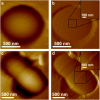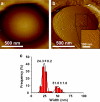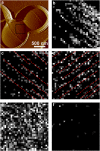Imaging the nanoscale organization of peptidoglycan in living Lactococcus lactis cells
- PMID: 20975688
- PMCID: PMC2964452
- DOI: 10.1038/ncomms1027
Imaging the nanoscale organization of peptidoglycan in living Lactococcus lactis cells
Abstract
The spatial organization of peptidoglycan, the major constituent of bacterial cell-walls, is an important, yet still unsolved issue in microbiology. In this paper, we show that the combined use of atomic force microscopy and cell wall mutants is a powerful platform for probing the nanoscale architecture of cell wall peptidoglycan in living Gram-positive bacteria. Using topographic imaging, we found that Lactococcus lactis wild-type cells display a smooth, featureless surface morphology, whereas mutant strains lacking cell wall exopolysaccharides feature 25-nm-wide periodic bands running parallel to the short axis of the cell. In addition, we used single-molecule recognition imaging to show that parallel bands are made of peptidoglycan. Our data, obtained for the first time on living ovococci, argue for an architectural feature of the cell wall in the plane perpendicular to the long axis of the cell. The non-invasive live cell experiments presented here open new avenues for understanding the architecture and assembly of peptidoglycan in Gram-positive bacteria.
Figures







References
-
- Sleytr U. B. & Beveridge T. J. Bacterial S-layers. Trends Microbiol. 7 253–260 (1999). - PubMed
-
- Archibald A. R., Hancock I. C. & Harwood C. R. in Bacillus Subtilis and Other Gram-Positive Bacteria: Biochemistry, Physiology, and Molecular Genetics (Sonenshein, A. L., Hoch, J. A. & Losick, R., eds) 381–410 (American Society for Microbiology, 1993).
-
- Delcour J., Ferain T., Deghorain M., Palumbo E. & Hols P. The biosynthesis and functionality of the cell-wall of lactic acid bacteria. Anton Leeuw Int. J. G 76 159–184 (1999). - PubMed
Publication types
MeSH terms
Substances
LinkOut - more resources
Full Text Sources
Other Literature Sources

